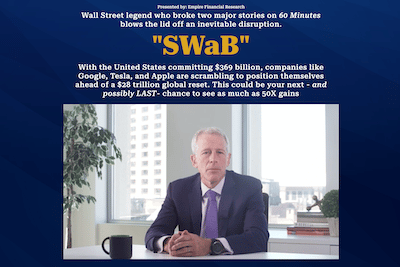I recently received an email about Jim Fink’s Personal Finance newsletter and thought I’d take a look to try to figure out if it’s worth joining or not.
In the presentation for Personal Finance, Jim talked about one of the main investment strategies he uses to help his subscribers make money – selling put options. And as a subscriber, he says he shows you how to make as much as $67,548 per year doing this.
Jim also shares other investment strategies for growing your wealth and earning income. All up, there are five model portfolios in the member’s area, each with different recommendations.
Overall, it’s quite a comprehensive service.
But as with any advisory, there are drawbacks to consider. So let’s take a closer look at what it’s about and how it works to help you decide if it’s right for you.
Overview of Jim Fink’s Personal Finance
Personal Finance is the flagship investment newsletter of Investing Daily, a popular investment education company, and it’s headed up by investing guru Jim Fink.
According to the Investing Daily website, the core focus of the service is on “safe, highly profitable investments that the mainstream herd hasn’t caught on to yet.”
As a subscriber of Personal Finance, you get a new newsletter issue every month that contains a detailed breakdown of major market trends and emerging investments.
You also get new investment recommendations from Jim Fink and the team over at Investing Daily and updates to the existing recommendations within the model portfolios.
All in all, there are five model portfolios inside the member’s area, and each caters to a different type of investor with different investing goals and risk tolerances.
Here are the five investment portfolios as of writing:
- Income
- Growth
- Maximum Income for Retirees
- Funds
- Options
Some portfolios are set up specifically to help subscribers earn income (like the Income and Maximum Income for Retirees portfolios). In contrast, others (like the Growth portfolio) contain opportunities to help you grow the value of your portfolio.
So subscribers get quite a diverse set of recommendations.
That said, many of Jim’s recommendations sway towards generating investment income and tend to cater more to conservative investors.
So even though the service can benefit virtually any investor, and his recommendations aren’t limited to any strategy or sector, they are more income-focused and risk-averse.
Another unique aspect of this newsletter versus others I’ve reviewed is that Jim recommends various option trading strategies. At first, this may seem counterintuitive because options are generally considered one of the riskiest strategies of all.
However, as I’ll explain shortly, Jim teaches subscribers a unique approach to trading options that can be less risky and help you generate regular investment income.
But before we get to that, let’s take a look at Jim Fink and his track record since he’s the main person behind the Personal Finance subscription.
Who Is Jim Fink?
Jim Fink is the Senior Analyst for the Personal Finance newsletter and contributes to two other advisory services published by Investing Daily – Options for Income and Velocity Trader.
According to his profile on the Investing Daily website, Jim holds a bachelor’s degree from Yale, a master’s from Harvard, a law degree from Columbia University, and an MBA from the University of Virginia. And before joining Investing Daily, he was a telecommunications lawyer.
How did he get into investing?
According to the Investing Daily website, Jim was “burning the midnight oil” for clients like Goldman Sachs and Citigroup as a lawyer in the 1980s and started spending his lunch hour at the “Chicago options exchange” to learn how to trade for himself.
And, after learning the ropes, turned $50K into $5.3 million within 10 years.
So I got friendly with some of the traders at the exchange – and started learning the ropes.
After a crash course in options trading… reading dozens of books… and pestering the seasoned market makers with countless questions… I began trading options myself.
I started out with $50,000 (much more than I needed, actually), and over the next 10 years continued to perfect this strategy.
By 2001, my $50,000 had grown into $5.3 million.
Jim Fink (source: www2.investingdaily.com/plp-pf-seconds-ex-ctrlro)
Jim’s Investing Daily profile also states that he worked for a university endowment, a private wealth management firm, and a financial planning company after getting out of law and that he’s been trading the market for the past 25 years.
During my research, I found that Jim Fink contributed to Motley Fool between 2005 and 2008 under the handle “XMFHamp.” And based on his Motley Fool profile page, he recommended 122 stock picks between 2006 to 2008, which performed quite well overall.
In fact, Jim is one of the highest-rated experts on Motley Fool.
I actually found this quite interesting because not only can you see how accurate his stock picks were during that time (hint: impressive), you can see the sectors he performed best in and his overall rank compared to other Motley Fool analysts.
Personally, I have a lot of respect for Motley Fool, so the fact Jim was an active contributor back in the day, with such a good track record, speaks volumes.
These days, Jim is probably best known for his work with Investing Daily, another well-known and respected financial education company.
And as I’ll explain shortly, Jim’s recommendations as part of the Personal Finance service appear to have outperformed the market.
Recommended: Go here to see my #1 rated stock advisory of 2024
How Does The Personal Finance Service Work?
The general idea behind the Personal Finance service is to sign up, read through the monthly issues that are sent to you, and use what you learn to become a successful investor.
The cost to join is $39.95 for one year or $79 for two years.
And as a member, you get 12 monthly issues of Personal Finance, access to five model portfolios, regular updates on the recommendations in the portfolios, and member forums.
Each issue contains a comprehensive analysis of some of the biggest market trends and emerging investment stories at the time of publishing, as well as new investment ideas.
And each recommendation you receive comes with all the details such as why it’s being recommended, what to buy, at what price, and so on. So that you can decide if you want to take advantage of Jim’s recommendations using your own brokerage account.
You also get access to some bonus reports and guides depending on which page you join through on the Investing Daily website.
For example, I discovered Personal Finance through the following page, which was all about making money through selling options…

And if you join through this page, you get the following training and resources aimed at helping you make money selling options:
- Options Strategy Manual (written training)
- Quick Start Options Training Program (video training)
- How to Buy Stocks at a Discount (companion report)
- Your First “Easy-Start” Options Trade (Jim’s latest trade recommendation)
What is option selling all about?
I talk about selling options in my review of a service called The Everyday Income System. But basically, instead of buying options, you can sell them to generate upfront income.
And even though these trades can go against you, the downside is generally lower than buying options, especially if you speculate on companies you are bullish on.
And the reason is that if you sell a put option and the underlying stock price goes up, nothing happens; you get to keep the premium you received for selling the options contract.
On the other hand, if the underlying stock price goes down, the “worst-case” is you have to buy shares in that company at a lower price than when you sold the options contract.
Which is a good thing if you already wanted to buy shares in that company, because now you get to own shares of a great company at a discount. And you can sell them whenever you want.
But there are risks involved.
And one of the biggest risks with this strategy is if the company’s share price collapsed. Because if that happened, even though you’d be buying the shares at a lower price than you would have if you’d bought them at the time you sold the options contract, you’d still take a loss overall.
So there are risks to consider, and it’s more complicated than simply buying and holding shares, so you need to know what you’re doing if you want to be successful.
And that’s where Jim Fink comes into play.
As a member of Jim’s Personal Finance service, you get access to his insights and recommendations to help you succeed with options trading and the other strategies he shares with subscribers. Which doesn’t guarantee you’ll make money following his recommendations, but the service does seem to have performed well over the past 20 odd years.
How Has The Newsletter Performed?
The Personal Finance newsletter began back in 1974, long before Jim joined it, and I’m not sure how well the service has performed during that time.
Also, as I mentioned earlier, there are different portfolios available within the member’s area, which each have a different track record.
And I was not able to find the individual track record of each Personal Finance portfolio, but the website does state that, over the past 15 years, the service has 3X’ed the S&P 500:
Overall, over the last decade and a half, the Personal Finance portfolios have racked up a total return nearly three times better than the S&P 500. By investing in our recommendations, you’d have been able to turn $100,000 into $281,000!
As of writing, and assuming the above text is both accurate and up-to-date, that means the Personal Finance newsletter has provided subscribers with recommendations that, on average, have resulted in 181% gains between 2006 to 2021.
The website also gives us a hint as to how well it performed in the 2000 to 2010 decade:
For example, from 2000-2010, the S&P 500 went backwards. Most Wall Street “experts” and fund managers did very poorly.
But during those same 10 years, which included the worst market crash since 1929, Personal Finance subscribers had the opportunity to gain almost 70%. And they did so while incurring 17% less risk, or volatility, than the market.
On top of these overall figures, Jim talks about how successful his options selling strategy has been. According to Jim, he’s used his options strategy, the same one he teaches subscribers, to generate an average of $185.06 per day, which works out to about $67,548 a year.
And apparently, he has an 84.68% win rate.
But as I said, out of the 346 total trade recommendations made over 50 months, 293 were profitable – that’s a “win rate” of 84.68%.
Of course, none of this guarantees that you’ll make money just by joining Personal Finance, and Jim is upfront about the fact that there are risks involved. But based on everything I’ve seen, it appears as though Jim is a real expert with a solid track record of success.
Is Personal Finance a Legitimate Service?
Yes, Personal Finance is a legitimate investment advisory service.
This service has been around since 1974, which is longer than almost every other service I’ve reviewed on this site. The only other advisories I’ve personally reviewed that have been around for a similar period of time are those published by Eagle Products.
Of course, just because something has been around for almost 50 years doesn’t automatically make it legitimate, but it does say a lot, in my opinion. Because if you were ripping people off, then you’d be lucky to last five years, let alone five decades.
In any case, Jim Fink, who joined the service sometime in the past couple of decades, is a real investing and trading expert with a solid track record.
And as mentioned earlier, at one point, he contributed to the Motley Fool, which is one of the most ethical and respected financial education companies in the world.
Also, as a subscriber of Personal Finance, you get access to the full archive of monthly issues going back 18 years, so you can see for yourself what Jim has recommended as part of this service during this time.
Lastly, the service comes with a 90-day money-back guarantee. So if you join and decide it’s not for you within your first 90 days, you can get your money back.
So with these things in mind, and based on everything I’ve seen, the conclusion I’ve come to is that this is a legitimate service.
Bottom Line – Is It Worthwhile?
The Personal Finance newsletter could be worthwhile if you’re interested in learning about a more conservative, income-focused investment strategy.
It could also be worth checking out if you want to learn how to make money selling options. Even though options can be risky, selling options is a strategy used by some of the most respected value investors, including the likes of Warren Buffet.
All in all, for less than $40 per year, there’s a lot of value on offer.
From monthly insights and recommendations to training and member forums, you get everything you need to learn from Jim and follow what he recommends.
That said, it’s probably not for people who are looking to make money investing in the next Netflix or Tesla. And if you want the full benefit of Jim’s options trading recommendations, you need to subscribe to his higher-priced service called Options for Income for $3K per year.
So, like any service, there are drawbacks. And even though it does appear to have a great track record, there are risks involved, so you’re not guaranteed to make money.
At the end of the day, whether or not it’s worthwhile really depends on you and your own personal circumstances and preference. Hopefully, what I’ve shared helps you decide if it’s right for you, but ultimately whether or not you join is something only you can decide.












Please note: By submitting a comment using the above comment form, you confirm that you agree with the storage and handling of your data by this site as detailed in our Privacy Policy.